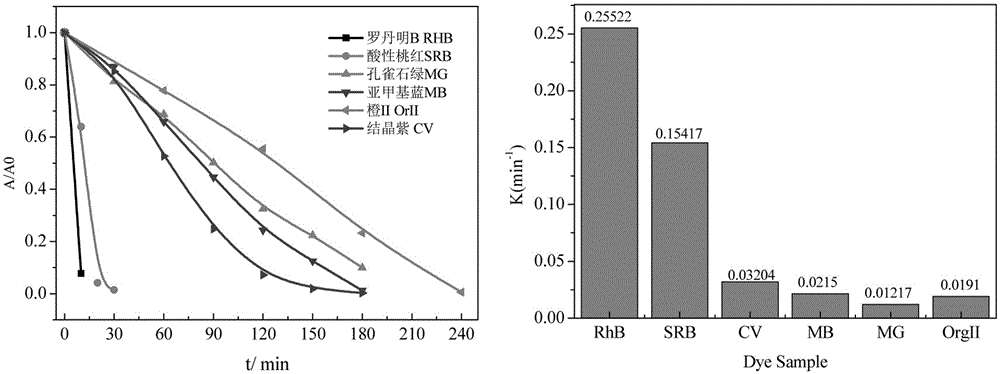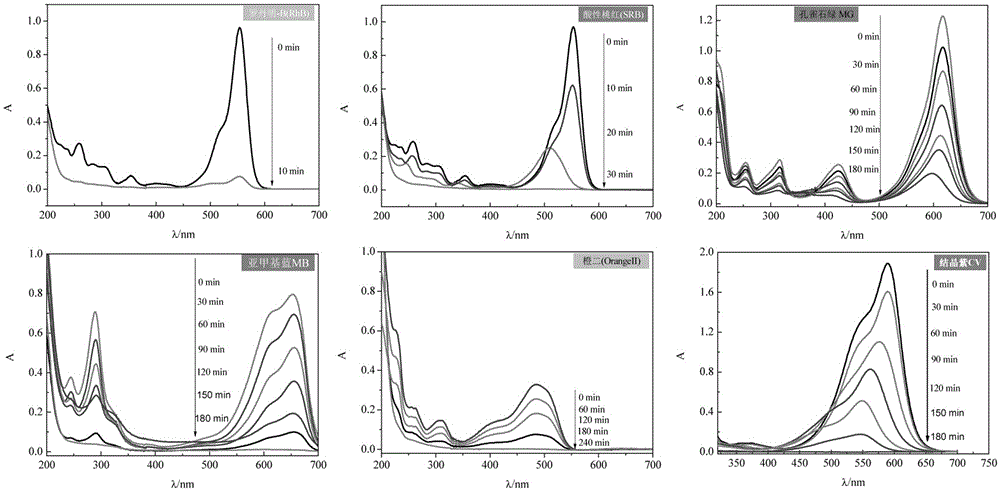Preparation method and application of BiVO4-BiOBr photocatalyst
A bismuth oxybromide and photocatalyst technology, applied in the direction of light water/sewage treatment, disinfection, irradiation, etc., can solve the problems of low photocatalytic efficiency of visible light, difficulty in electron and hole migration, low redox potential, etc. The effect of uniform appearance, reliable source and good dispersion
- Summary
- Abstract
- Description
- Claims
- Application Information
AI Technical Summary
Problems solved by technology
Method used
Image
Examples
Embodiment 1
[0034] Weigh 1.940g (0.004mol) Bi(NO 3 ) 3 ·5H 2 O and 0.468g (0.004mol) NH 4 VO 3 respectively in 30mL 2.0mol / L HNO 3 Dissolve in 30mL 2mol / L NaOH by ultrasonic for 30min, then slowly inject any one of the liquids into another liquid with a syringe, and continue ultrasonication for 30min to make it completely dispersed, then use 6mol / LNaOH and 5mol / L HNO 3 Adjust the pH of the solution to 7.8, then stir for 1 hour, transfer to a high-pressure reactor, and react at 160°C for 12 hours. After natural cooling, the sample is filtered with suction and washed with a large amount of water, and dried at 50°C to obtain the monoclinic scheelite phase BiVO 4 catalyst.
[0035] Weigh the synthesized monoclinic phase BiVO 4 Catalyst 0.648g (0.002mol), Bi(NO 3 ) 3 ·5H 2 O 1.94g (0.004mol) and NaBr 0.41g (0.004mol) were added to ethanol and sonicated for 30min to obtain three homogeneously dispersed precursors. 4 The precursor and the NaBr precursor were injected separately (Bi(NO ...
Embodiment 2
[0043] Weigh 1.940g (0.004mol) Bi(NO 3 ) 3 ·5H 2 O and 0.468g (0.004mol) NH 4 VO 3 respectively in 30mL2.0mol / L HNO 3 Dissolve in 30mL 2mol / L NaOH by ultrasonic for 30min, then slowly inject any one of the liquids into another liquid with a syringe, and continue ultrasonication for 30min to make it completely dispersed, then use 6mol / LNaOH and 5mol / L HNO 3 Adjust the pH of the solution to 5.8, then stir for 1 hour, transfer to a high-pressure reactor, and react at 160°C for 12 hours. After natural cooling, the sample is filtered with suction and washed with a large amount of water, and dried at 50°C to obtain the monoclinic scheelite phase BiVO 4 catalyst.
[0044] Weigh the synthesized monoclinic phase BiVO 4 Catalyst 0.648g (0.002mol), (Bi(NO 3 ) 3 ·5H 2 O) 1.94g (0.004mol) and NaBr 0.41g (0.004mol) were added to ethanol and sonicated for 30min to obtain three homogeneously dispersed precursors, and the BiVO 4 The precursor and the NaBr precursor were injected sepa...
Embodiment 3
[0046] Weigh 1.940g (0.004mol) Bi(NO 3 ) 3 ·5H 2 O and 0.468g (0.004mol) NH 4 VO 3 respectively in 30mL2.0mol / L HNO 3 Dissolve in 30mL 2mol / L NaOH by ultrasonic for 30min, then slowly inject any one of the liquids into another liquid with a syringe, and continue ultrasonication for 30min to make it completely dispersed, then use 6mol / LNaOH and 5mol / L HNO 3 Adjust the pH of the solution to 7.8, then stir for 1 h, transfer to a high-pressure reactor, and react at 200 ° C for 12 h. After natural cooling, the sample is filtered with suction and washed with a large amount of water, and dried at 50 ° C to obtain the monoclinic scheelite phase BiVO 4 catalyst.
[0047] Weigh the synthesized monoclinic phase BiVO 4 Catalyst 0.648g (0.002mol), Bi(NO 3 ) 3 ·5H 2 O 1.94g (0.004mol) and NaBr 0.41g (0.004mol) were added to ethanol and sonicated for 30min to obtain three homogeneously dispersed precursors. 4 The precursor and the NaBr precursor were injected separately (Bi(NO 3 )...
PUM
| Property | Measurement | Unit |
|---|---|---|
| thickness | aaaaa | aaaaa |
Abstract
Description
Claims
Application Information
 Login to View More
Login to View More - R&D Engineer
- R&D Manager
- IP Professional
- Industry Leading Data Capabilities
- Powerful AI technology
- Patent DNA Extraction
Browse by: Latest US Patents, China's latest patents, Technical Efficacy Thesaurus, Application Domain, Technology Topic, Popular Technical Reports.
© 2024 PatSnap. All rights reserved.Legal|Privacy policy|Modern Slavery Act Transparency Statement|Sitemap|About US| Contact US: help@patsnap.com










